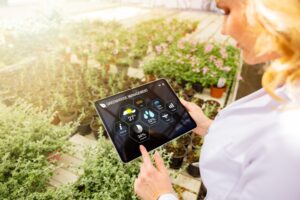Did you know? According to the data from the Food and Agriculture Organization (FAO) of the United Nations, by 2050, there will be 9.7 billion people worldwide. This means that, compared to 2024, there would be around 2 billion more mouths to feed. This increase in the number of individuals in the world must be met with a 70% rise in agricultural production. The situation poses a crucial challenge because the food industry is presently responsible for 30% of the world’s energy consumption and 22% of its greenhouse gas emissions. Therefore, the challenge is not only about increasing food production but also about doing it sustainably. Thus, smart farming and precision agriculture are cruicial to support this growth.

Source: Freepik
Smart Farming and Precision Agriculture in Simple Terms:
Smart farming is about using the latest technologies to increase production quantity and quality by maximizing the use of resources with the least environmental impact. Technologies include sensors, robotics, data analytics, and Internet of Things (IoT). These technologies are used to monitor and manage crops, land use, and livestock much more efficiently. It helps farmers to collect and analyze data about soil conditions, plant health, weather patterns, and other factors that affect the crop growth and overall yield. Also, this data is used to make better and more informed decisions about fertilizing, planting, and irrigating crops, and identifying the problems much more quickly.
Different Types of Smart Farming:
There are different types of smart farming technologies, and all of them serve different purposes. These technologies include:
- Precision farming includes data analytics, GPS mapping, and advanced sensors for monitoring soil and plant conditions, weather patterns, and all other factors that affect the overall crop growth. The data obtained from the sensors is analyzed to create precise maps of the farmland that can be used to optimize the crop planting, fertilization, and irrigation. Therefore, the farmers can make better, more informed decisions.
- Robotic farming includes using robots to assist with planting, pruning, and harvesting, among many other laborious tasks. Robotics help reduce labor costs and improve farming operations as the robots can operate continuously without breaks. Robotic farming lessens or eliminates the requirement for manual labor and is helpful in those areas where labor shortages are common.
- Agribusiness management includes using software and data analytics for maintaining farming operations like supply chain management, inventory management, and financial analysis. This is one of the best forms of smart farming that empowers farmers with their operations by offering insights into crop yield, cost, and profitability metrics. By analyzing this data, farmers can make much more informed decisions about when and where to invest and determine the opportunities to reduce waste and increase efficiency.
- Vertical farming includes growing crops indoors in a climate-controlled environment using hydroponic systems. This technology is used in urban environments or areas where traditional farming is difficult because of the climate, soil quality, or other factors. Vertical farms are designed to optimize light, space, and water use and can also grow crops throughout the year, regardless of the weather outside. Vertical farming also reduces the requirement for pesticides and other chemicals and eliminates the environmental impact of farming.
Technologies Used in Smart Agriculture and Precision Farming:
Smart agriculture is a diverse field that uses many technologies to improve farming practices. Here are some of the critical technologies used in smart agriculture and precision farming:
- Sensors and IoT devices are crucial to collect real-time data on environmental and farming conditions. Soil moisture sensors help farmers in determining when to water the crops, and how much. The temperature and humidity sensors help optimize climate control in greenhouses. IoT devices can also track livestock location and behavior, health metrics, and feeding patterns, providing valuable insights for herd management.
- Drones are used in smart farming for collecting data on crop growth and health, monitoring irrigation systems, and detecting pest infestations. Capturing aerial images of the fields, the drones can identify the areas where the crops might be under stress or are suffering from nutrition deficiencies. Drones can also be used in spraying crops with pesticides and fertilizers, reducing labor costs and minimizing exposure to chemicals for farmers.
- Autonomous tractors and other farm equipment are becoming popular because they can perform repetitive tasks like tilling, planting, and harvesting with better efficiency and accuracy. With sensors, autonomous tractors can quickly plant the seeds and detect variations in soil quality.
- Machine learning and AI analyze the data obtained by sensors and IoT devices. It helps farmers to optimize crop yields and reduce waste with predictive models and algorithms. For instance, machine learning algorithms can analyze weather patterns, soil moisture, and crop growth data for predicting crop yields and suggest optimal planting times.
SoilOptix® technology offers an entirely new perspective on soil information for farmers. Visit https://soiloptix.com/ to learn the benefits of smart farming and precision agriculture today!
